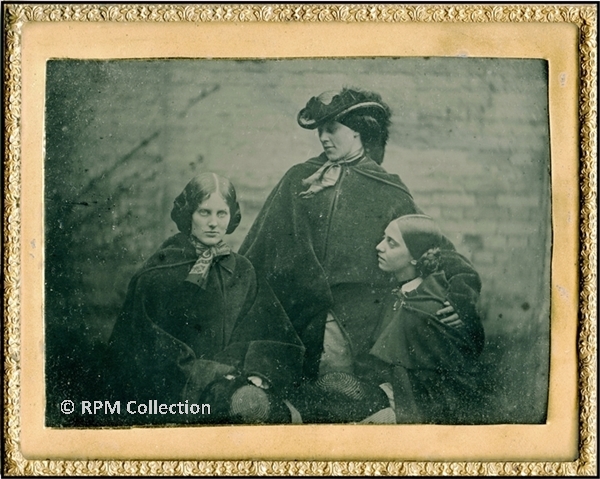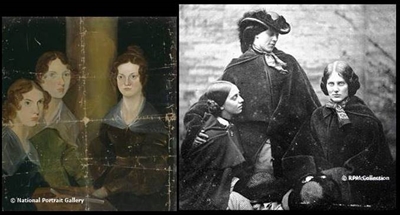|
The Photograph

This is a collodion photo with "The Bronte Sisters" written in
French on the reverse, however this type of photograph on glass only existed from the
early 1850s, after the death of Emily (1848) and Anne (1849).
The researcher's experience in photography spans three decades and includes
printing thousands of photographs from glass negatives such as this. He believes that this is a
copy of an earlier 1840s photo known as a daguerreotype. The photo is on a slight slant and
has the appearance of having been cropped. This is how daguerreotypes were often copied, at an
angle to avoid reflections and centred to avoid marks at the edges of the original photo.
Provenance.
The image is in a photographic archive in Scotland. As with most photos there is
virtually no provenance and it can only be traced back to the previous owners in France. It is
thought that they purchased it in the Paris area.
Photographs of the Bronte Sisters.
Charlotte Bronte first used the term daguerreotyped early
in January 1848 which suggests that she had recently seen a photograph. This was within
four weeks of the three sisters secretly becoming published authors; even their own father was
unaware, despite the fact that they were all living under the same roof. There
is no record of a photo being taken of the Bronte sisters but, given the history of other
portraits, there may be very good reasons for this. 1.
Opinions.
The Bronte sisters photo was initially thought to be one
of a number of copies sold to visitors in 1850s Haworth, but this turned out not to be
the case. The Bronte Parsonage Museum viewed the photo in 2011 but knew of no photograph
of the Bronte Sisters. After an enlightening discussion we suggested the use
of scientific analysis to determine whether or not the photo is of the Bronte
sisters, but, as we understand was the case with Audrey Hall's 'photograph of
Charlotte', these methods were not trusted and are not accepted.
A visit to the National Media Museum proved inconclusive; one member of staff
said that it was unlikely to be a copy because they are far less common than original photos,
another said that “it has that look of a copy about it.” The NMM couldn't help because it
wasn't thought possible to confirm whether a photograph is an original, taken of people from
several feet away, or a copy of a photo taken from several inches away. Since then, photographic
historians have suggested that as there are blemishes on the photo it may be possible to determine
whether these are on the photo or - if a copy - on the surface of the copied photo.
The Hats
The 'wide-awake' style of hat seen in the photo did exist the early 1860s
but was popular in England in 1847-9. It was named after the then famous Swedish opera
singer, Jenny Lind, one of the few female role models of the 1840s.
Comparing Portraits
One major problem in comparing images of the sisters is that over the years
several Bronte portraits were wrongly identified. These are still used today and give a
very distorted view of what the sisters looked like. If the published portraits are to be believed
then Emily was Anne's twin and Charlotte Bronte was Ellen Nussey's twin. This was
not the case. An attempt has been made to discover which portraits are wrong or misleading so
that a fair comparison can be made with the ladies in the photo. Where possible, only contemporary
descriptions have been used, by people who actually knew or met the Bronte sisters.
The Website Structure
The website is divided into sections. In COMPARE
PORTRAITS the undisputed portraits are listed, followed by those
considered to be idealised, mistaken or wrongly identified. Genuine images
of Charlotte, Emily and Anne are then compared with the ladies in the photo.
Three sections focus on the decades 1840s-1860s;
the theory is that a daguerreotype photograph was taken in the
1840s and that this is a collodion copy made in
the 1850s. The photo is in effect a glass negative and there is evidence
that a print on paper was in London in the 1860s.There
is a SUMMARY but as yet no conclusion.
More detailed information on several portraits of the
Bronte sisters is in the section Confusing Portraits.
Orientation of the Photo.
If the 1850s collodion photo is a copy of an 1840s daguerreotype
then it is correctly orientated with 'Charlotte' on the left, her hair parted on her left
and crooked mouth turning down on her right. An original daguerreotype would however have
been a reversed image, and viewed as below, with 'Charlotte' on the right and composition
similar to Branwell's group portrait at the NPG.

Branwell's group 'Pillar' portrait was hidden away in a wardrobe, not seen by
the public until 1914.
The collodion photo was created fifty or sixty years before this date.
If these are the Bronte sisters then the photo is a copy of an 1840s daguerreotype.
The Website
The website was set up in 2012, the aim being to discover whether or
not these are the Bronte sisters. The original intention was to
thoroughly investigate the photograph but sudden unforeseen commitments prevented
this and so it remains a project for the future. Some work is carried out
when time permits, a few days each month, and the website is updated once or twice a year.
|

